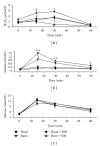Decreased skin-mediated detoxification contributes to oxidative stress and insulin resistance
- PMID: 22899900
- PMCID: PMC3415238
- DOI: 10.1155/2012/128694
Decreased skin-mediated detoxification contributes to oxidative stress and insulin resistance
Abstract
The skin, the body's largest organ, plays an important role in the biotransformation/detoxification and elimination of xenobiotics and endogenous toxic substances, but its role in oxidative stress and insulin resistance is unclear. We investigated the relationship between skin detoxification and oxidative stress/insulin resistance by examining burn-induced changes in nicotinamide degradation. Rats were divided into four groups: sham-operated, sham-nicotinamide, burn, and burn-nicotinamide. Rats received an intraperitoneal glucose injection (2 g/kg) with (sham-nicotinamide and burn-nicotinamide groups) or without (sham-operated and burn groups) coadministration of nicotinamide (100 mg/kg). The results showed that the mRNA of all detoxification-related enzymes tested was detected in sham-operated skin but not in burned skin. The clearance of nicotinamide and N(1)-methylnicotinamide in burned rats was significantly decreased compared with that in sham-operated rats. After glucose loading, burn group showed significantly higher plasma insulin levels with a lower muscle glycogen level than that of sham-operated and sham-nicotinamide groups, although there were no significant differences in blood glucose levels over time between groups. More profound changes in plasma H(2)O(2) and insulin levels were observed in burn-nicotinamide group. It may be concluded that decreased skin detoxification may increase the risk for oxidative stress and insulin resistance.
Figures







Similar articles
-
Nicotinamide overload may play a role in the development of type 2 diabetes.World J Gastroenterol. 2009 Dec 7;15(45):5674-84. doi: 10.3748/wjg.15.5674. World J Gastroenterol. 2009. PMID: 19960564 Free PMC article.
-
[Effects of low-dose insulin on oxidation-reduction in rat organs after major burns].Zhonghua Yi Xue Za Zhi. 2013 Nov 12;93(42):3394-7. Zhonghua Yi Xue Za Zhi. 2013. PMID: 24418039 Chinese.
-
Excessive nicotinic acid increases methyl consumption and hydrogen peroxide generation in rats.Pharm Biol. 2013 Jan;51(1):8-12. doi: 10.3109/13880209.2012.697175. Epub 2012 Sep 12. Pharm Biol. 2013. PMID: 22971213
-
Blockade of the renin-angiotensin system improves insulin sensitivity in thermal injury.Shock. 2006 Nov;26(5):485-8. doi: 10.1097/01.shk.0000230302.24258.9f. Shock. 2006. PMID: 17047519
-
Burn injury impairs insulin-stimulated Akt/PKB activation in skeletal muscle.Am J Physiol Endocrinol Metab. 2005 Mar;288(3):E585-91. doi: 10.1152/ajpendo.00321.2004. Epub 2004 Nov 9. Am J Physiol Endocrinol Metab. 2005. PMID: 15536206
References
-
- Houstis N, Rosen ED, Lander ES. Reactive oxygen species have a causal role in multiple forms of insulin resistance. Nature. 2006;440(7086):944–948. - PubMed
-
- Zhou SS, Zhou YM, Li D, Lun YZ. Dietary methyl-consuming compounds and metabolic syndrome. Hypertension Research. 2011;34(12):1239–1245. - PubMed
-
- Mena S, Ortega A, Estrela JM. Oxidative stress in environmental-induced carcinogenesis. Mutation Research—Genetic Toxicology and Environmental Mutagenesis. 2009;674(1-2):36–44. - PubMed
-
- Valko M, Morris H, Cronin MTD. Metals, toxicity and oxidative stress. Current Medicinal Chemistry. 2005;12(10):1161–1208. - PubMed
Publication types
MeSH terms
Substances
LinkOut - more resources
Full Text Sources
Medical
